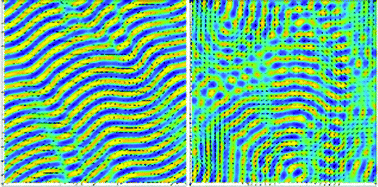Coupling Turing stripes to active flows†
Abstract
We numerically solve the active nematohydrodynamic equations of motion, coupled to a Turing reaction–diffusion model, to study the effect of active nematic flow on the stripe patterns resulting from a Turing instability. If the activity is uniform across the system, the Turing patterns dissociate when the flux from active advection balances that from the reaction–diffusion process. If the activity is coupled to the concentration of Turing morphogens, and neighbouring stripes have equal and opposite activity, the system self organises into a pattern of shearing flows, with stripes tending to fracture and slip sideways to join their neighbours. We discuss the role of active instabilities in controlling the crossover between these limits. Our results are of relevance to mechanochemical coupling in biological systems.



 Please wait while we load your content...
Please wait while we load your content...